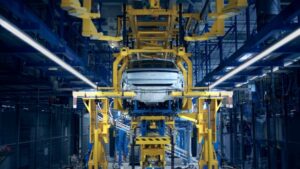The shift towards electric vehicles (EVs) is in full swing, driven by global initiatives such as President Biden’s call for 50% of new passenger vehicle sales to be electric by 2030.
Yet, this transition is facing significant hurdles, as illustrated by the recent controversies surrounding Ford.
 Currently, Ford is under scrutiny from three influential House committees regarding its deal with China’s CATL battery maker. This deal, involving the licensing of battery cell technology, has sparked concerns about CATL’s ties to the Chinese Communist Party. Consequently, the construction of a $3.5 billion battery plant in Michigan has been temporarily halted. This situation emphasizes the complex interplay of geopolitics, business partnerships, and regulatory scrutiny that automakers must navigate in their pursuit of electrification.
Currently, Ford is under scrutiny from three influential House committees regarding its deal with China’s CATL battery maker. This deal, involving the licensing of battery cell technology, has sparked concerns about CATL’s ties to the Chinese Communist Party. Consequently, the construction of a $3.5 billion battery plant in Michigan has been temporarily halted. This situation emphasizes the complex interplay of geopolitics, business partnerships, and regulatory scrutiny that automakers must navigate in their pursuit of electrification.
President Biden’s ambitious goals for EV adoption, aiming for two-thirds of new vehicle sales to be electric by 2032, face a formidable challenge. Despite these targets, the current market share for EVs is only at 7%, indicating the substantial reallocation of resources, capital, and skilled personnel required for a successful transition.
Ford’s attempt to manufacture EVs domestically by partnering with CATL underscores the global nature of the EV supply chain. However, this international collaboration has attracted congressional attention due to concerns about foreign ties, highlighting the delicate balance automakers must strike amidst geopolitical complexities.
Ford’s challenges are not unique but mirror broader issues faced by the automotive industry, including persistent supply chain problems, high borrowing costs, and the need for substantial investments in new capital equipment. The transition to EVs demands not only a technological shift but also a restructuring of business models and partnerships, adding complexity to an already challenging landscape.
While the Biden administration promotes EV adoption, it simultaneously imposes restrictive rules on the industry, influencing sourcing decisions, technology choices, and labor-related matters. The administration’s active involvement raises questions about unintended consequences and potential industry backlash, exemplified by President Biden joining a picket line with United Auto Workers.
The challenges extend beyond the U.S., as seen in Ford’s abandoned joint venture in Turkey with LG Energy Solution, reflecting wider uncertainties in the global market regarding consumer electrification adoption.
A critical aspect of the EV transition is the allocation of resources for battery production. Ford’s challenges highlight the intricate international partnerships required to access crucial resources for EV batteries. Scrutiny over ties to CATL raises questions about the reliability and sustainability of global supply chains for materials essential to battery production. Additionally, the environmental impact, human rights concerns, and geopolitical implications of mining processes for lithium, cobalt, and other essential elements add another layer of complexity to the resource acquisition challenge.
In essence, Ford’s current struggles offer insights into the complex landscape of the EV transition. As the automotive industry grapples with geopolitical intricacies, regulatory constraints, and economic uncertainties, achieving ambitious EV goals requires adept navigation of a multifaceted landscape. Ford’s experiences serve as valuable lessons for the entire industry as it charts its course in this transformative era towards a sustainable and electrified future.




